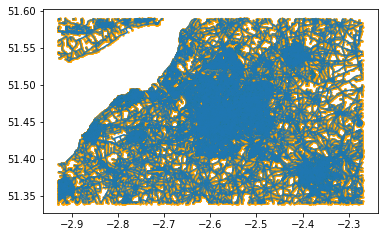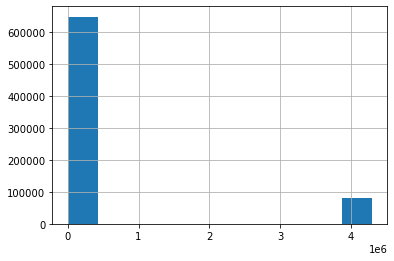Retrieving custom networks from OSM using Pyrosm and translating to Pandana and NetworkX

Introduction
Pyrosm is a very clever python library, written by Henrikki Tenkane, that allows users to quickly and effectively retrieve data from OpenStreetMap, using Cython and Protocolbuffer Binary Format -files (PBFs). It is ultimately the most useful tool to retrieve OSM data within python and is fairly well documented.
Yet, there were few places which can be confusing and where extended description and tutorial is needed. This is specifically;
- retrieving custom network (cycling example)
- converting custom network to Pandana/Networkx graph
In this tutorial, I'll also repeat the distances calculation with pandana from this post and update on any changes.
I would have like to contribute to the Pyrosm library with the first point, however, Cython is not amongst my skills right now. So if someone knows how to do that, feel free.
Retrieving custom driving/walking/cycling network
The Pyrosm uses custom_filter to define what features should be extracted from the PBF, however, this filter is not available for the networks. Instead the Pyrosm offers get_data_by_custom_criteria() and keep vs exclude feature which allows you to define which keys to keep or exclude from the OSM. This function also allows you to choose if you want to keep the nodes in the data, but those are not the network nodes, those are point features that has the tags defined in your custom filter. This means, that you can get custom network, but only the edge list. However, in order to construct graph in Pandana we need both edge list and node list. Now you could just get the edge list, create a graph in Networkx and then translate to Pandana by exporting edgelist and node list out, but let's be realistic. If there is a way to avoid multiple conversions and installing another package, I would be much happier.
I found an easy way to retrieve both nodes and edges for custom created network. The process is as follows;
- Retrieve complete network for the selected area
- Filter out the edges features based on selected keys from OSM
- List all the existing nodes in the edge dataframe
- Filter the nodes by the list from the previous step
# import the necessary packages
import geopandas as gpd
import pandas as pd
# import pyrosm functions
from pyrosm import OSM
from pyrosm import get_data
# network libraries
import pandana
import networkx as nx
def get_network_custom(place,filter_type):
"""
place: string
name of the pbf to be downloaded
filter_type: string
'cycling' only for now
"""
# connect to the data
osm = OSM(get_data(place))
## if you have already downloaded pbf file and it’s in your file directory use following
## osm = OSM(place)
## where place is 'filepath.pbf'
# retrieve the complete network
nodes,edges = osm.get_network(nodes=True, network_type="all")
# define the filter
if filter_type == 'cycling':
highway = ['primary',
'primary_link',
'trunk',
'trunk_link',
'secondary',
'secondary_link',
'tertiary',
'tertiary_link',
'unclassified',
'residential',
'living_street',
'road',
'service',
'track',
'path',
'pedestrian',
'footway',
'bridleway',
'cycleway',
'busway']
else: raise ValueError('try cycling')
# you could define other profiles such as driving or walking
# choose only those edges that are inside the filter
edges = edges[edges['highway'].isin(highway)]
# list origin nodes
list_origins = list(edges.u.unique())
# list destination nodes
list_destinations = list(edges.v.unique())
# combine the to lists to see all nodes that exist in filtered network
list_nodes = list_origins + list_destinations
# cut the nodes by the existing list
nodes_gdf = nodes[nodes.id.isin(list_nodes)]
return nodes_gdf,edges
nodes, edges = get_network_custom('Bristol','cycling')
ax = edges.plot()
nodes.plot(ax = ax, color = 'orange', markersize = 2);

Converting custom network to pandana/networkx graph
Converting the two geodataframes to graphs is then dead easy.
nodes.info()
<class 'geopandas.geodataframe.GeoDataFrame'>
Int64Index: 515871 entries, 0 to 522320
Data columns (total 8 columns):
# Column Non-Null Count Dtype
--- ------ -------------- -----
0 lon 515871 non-null float64
1 lat 515871 non-null float64
2 tags 20935 non-null object
3 timestamp 515871 non-null int8
4 version 515871 non-null int8
5 changeset 515871 non-null int8
6 id 515871 non-null int64
7 geometry 515871 non-null geometry
dtypes: float64(2), geometry(1), int64(1), int8(3), object(1)
memory usage: 25.1+ MB
edges.info()
<class 'geopandas.geodataframe.GeoDataFrame'>
Int64Index: 551813 entries, 0 to 560619
Data columns (total 43 columns):
# Column Non-Null Count Dtype
--- ------ -------------- -----
0 access 45542 non-null object
1 area 10881 non-null object
2 bicycle 40145 non-null object
3 bridge 2960 non-null object
4 busway 84 non-null object
5 cycleway 7300 non-null object
6 est_width 785 non-null object
7 foot 87694 non-null object
8 footway 5027 non-null object
9 highway 551813 non-null object
10 int_ref 0 non-null object
11 junction 6390 non-null object
12 lanes 30165 non-null object
13 lit 49202 non-null object
14 maxspeed 97150 non-null object
15 motorcar 672 non-null object
16 motorroad 8 non-null object
17 motor_vehicle 8631 non-null object
18 name 202888 non-null object
19 oneway 49142 non-null object
20 overtaking 61 non-null object
21 path 835 non-null object
22 passing_places 47 non-null object
23 psv 873 non-null object
24 ref 25646 non-null object
25 service 45451 non-null object
26 segregated 13048 non-null object
27 sidewalk 38667 non-null object
28 smoothness 2099 non-null object
29 surface 145345 non-null object
30 tracktype 5161 non-null object
31 tunnel 1281 non-null object
32 turn 7 non-null object
33 width 3221 non-null object
34 id 551813 non-null int64
35 timestamp 551813 non-null int64
36 version 551813 non-null int8
37 tags 183067 non-null object
38 osm_type 551813 non-null object
39 geometry 551813 non-null geometry
40 u 551813 non-null int64
41 v 551813 non-null int64
42 length 551813 non-null float64
dtypes: float64(1), geometry(1), int64(4), int8(1), object(36)
memory usage: 181.6+ MB
# This might be necessary if you get the error
## ValueError: Buffer dtype mismatch, expected 'long' but got 'double'
nodes2 = nodes.set_index('id')
# create pandana graph
pandana_graph = pandana.Network(nodes2['lon'],
nodes2['lat'],
edges['u'],
edges['v'],
edges[['length']],
twoway=[False,True])
# create networkx graph
networkx_graph = nx.from_pandas_edgelist(edges,source = 'u', target = 'v', edge_attr = 'length')
Calculating shortest distance between set of points using pandana
pois = gpd.read_file("./points.geojson")
pois2 = pois.rename(columns = {'ID_code':'code_ID'})
import itertools
def get_shortest_path(points, polygons, point_id, poly_id, Graph):
# check the projections
if points.crs != 'EPSG:4326':
raise ValueError("The point CRS is not Mercator, Use gpd.to_crs('EPSG4326') to transform the CRS")
if polygons.crs != 'EPSG:4326':
raise ValueError("The polygon CRS is not Mercator, Use gpd.to_crs('EPSG4326') to transform the CRS")
"""
Parses graph and two sets of locational datasets and returns dataframe with Origin destination ids, distances and times along the network.
Parameters
----------
point : point geodataframe
polygons : polygon or second point geodataframe
point_id : str
unique ID column of points
poly_id : str
unique ID column of polygons or the second points
Graph: object
pandana.network
Returns
-------
dataframe with distances and times between each pair of points
Return type
-----------
pandas.dataframe
"""
# define the unique origins and destinations
origins = list(points[point_id].unique())
destinations = list(polygons[poly_id].unique())
# create OD data
od_data = pd.DataFrame(list(itertools.product(origins,destinations))).rename(columns = {0:point_id,1:poly_id})
# add coordinates to the data
# if the data is other then points, it would take centrooid of the geometry
if points.type[0] == 'Point':
point_xy = pd.DataFrame({point_id: points[point_id], 'X':points.geometry.x, 'Y':points.geometry.y}).reset_index(drop=True)
elif points.type[0] == 'MultiPoint':
point_xy = pd.DataFrame({point_id: points[point_id], 'X':points.geometry.x, 'Y':points.geometry.y}).reset_index(drop=True)
else: point_xy = pd.DataFrame({point_id: points[point_id], 'X':points.geometry.centroid.x, 'Y':points.geometry.centroid.y}).reset_index(drop=True)
if polygons.type[0] == 'Point':
poly_xy = pd.DataFrame({poly_id: polygons[poly_id], 'X':polygons.geometry.x, 'Y':polygons.geometry.y}).reset_index(drop=True)
elif polygons.type[0] == 'MultiPoint':
poly_xy = pd.DataFrame({poly_id: polygons[poly_id], 'X':polygons.geometry.x, 'Y':polygons.geometry.y}).reset_index(drop=True)
else: poly_xy = pd.DataFrame({poly_id: polygons[poly_id], 'X':polygons.geometry.centroid.x, 'Y':polygons.geometry.centroid.y}).reset_index(drop=True)
# build origin destination data
od_data = od_data.merge(point_xy, on=point_id, how = 'left').merge(poly_xy, on = poly_id, how = 'left')
# find nodes on the network
origin_nodes = Graph.get_node_ids(od_data.X_x, od_data.Y_x).values
dests_nodes = Graph.get_node_ids(od_data.X_y, od_data.Y_y).values
# find the distances and times
od_data['distance'] = pd.Series(Graph.shortest_path_lengths(origin_nodes, dests_nodes, 'length'))
return od_data
import time
start = time.time()
dists = get_shortest_path(points = pois, polygons = pois2, point_id = 'ID_code', poly_id = 'code_ID', Graph = pandana_graph)
end = time.time()
print(end - start )
9.235082149505615
dists.distance.hist();

Notes: You can see that there is a suspicious distance that are bigger than 300 000 meters. This happens when the graph can't find the route for set of two points. This is most likely because one of the nodes is on disconnected graphs within the network and can't reach the other ones, or they could be outside the graph extent or something else. It would be smart to investigate the graph, but that’s not part of this post :)